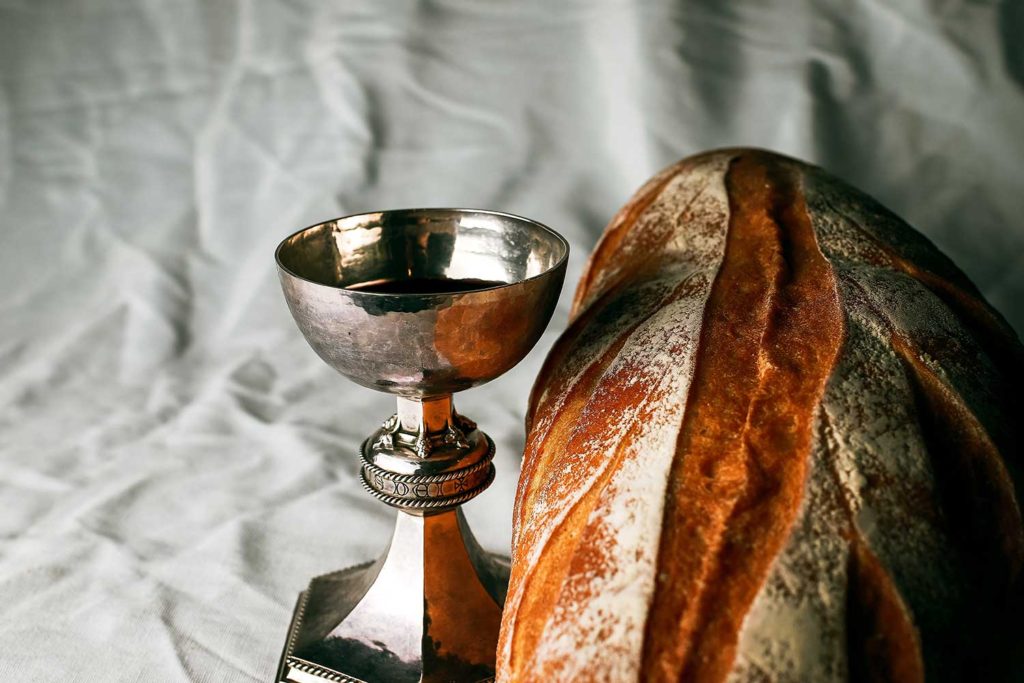August 15, 2021
The Rev. Canon Marianne Wells Borg
Trinity Episcopal Church, Bend, Oregon
John 6: 51-58
So what do we think is meant by eating the flesh and drinking the blood of Jesus. John writes “Unless you eat the flesh of the Son of Man and drink his blood you have no life in you. My flesh is true food and my blood is true drink. The one who eats this bread will live forever.” What are we to make of this?
“How can this man give us his flesh to eat?” A question asked in our Gospel story.
This language is meant to get our attention. Meant to grab us. Even make us uncomfortable. But if we take this language literally – which it was never intended to be — it is disturbing. And absurd.
So what kind of language is this?
A useful if not necessary question when reading our Gospel stories.
And our gospel stories are just that: Stories. That doesn’t mean they are not true. But most of these stories are not to be mistaken as factual. Nor to be taken literally. Stories about Jesus are a mixture of history remembered and memory interpreted. These stories are intended to convey a truth. But not like a journalistic report.
The language in today’s gospel, the language of flesh and blood and eating and drinking I suggest is more theopoetic then theologic. As Robert Frost wrote, Christ came to make a break with logic. Christ came to make a break with logic. And I think the author of this Gospel is doing the same.
Theopoetic comes from the Greek word poiesis which means to make. Or create. Or bring something into being that didn’t exist before. Theos is the Greek for God. So something is happening in theopoetic language. It creates an experience. And it is up to us to wonder what. It is not literal language. It is suggestive.
John’s language about Jesus being living bread and eating his flesh and drinking blood is not literal. We know that. We know that. We know this language is not to be taken literally. And John knew this language was not to be taken literally. Which is why he included the question how can this man give up his flesh to eat. The questioner obviously didn’t get it. John’s language is symbolic. As is the language of theopoetics. And a symbol is not to be mistaken for the thing itself. It begs for interpretation. It persistently pecks at the limits of our logical thinking. Like a chick inside an egg. Begging to get out.
But if a theopoetic invitation is mistaken as the stuff of a propositional statement we court theological trouble.
And with this in mind I suggest that the Eucharistic language of receiving the body and blood of Jesus has been interpreted too literally.
When I was in seminary we were taught that the moment when the priest called upon the Holy Spirit to change the bread and wine into the “actual body and blood of Jesus” was the epiclesis. Epi meaning upon. And clesis meaning call. Calling upon the Holy Spirit. There is a long history in the Christian tradition of describing this act of calling upon the Holy Spirit as transubstantiation. The belief that the bread and wine become Jesus’ body and blood. It was one of the indicators of devotion and faith. I think the emphasis on transubstantiation makes a theopoetic image into a propositional statement. And has gotten us into theological trouble. And not good trouble.
I remember years ago a woman came to me because she was disturbed and puzzled by the language in our Eucharistic liturgy. And she asked me what is the church asking me to swallow here? I thought that was a telling question. Not unlike the one in our gospel.
I take the Eucharist very seriously. I don’t take the language literally. As symbolic language it has meaning. Profound meaning. Instructive meaning for us. And I will make use of this passage in John’s gospel as though it is Eucharistic language to make my point.
John has Jesus say I am the living bread. And then goes on to have Jesus say “whoever eats of this bread will live forever. And the bread that I will give for the life of the world is my flesh.”
This is theopoetic language. Symbolic. Bread here is the operative symbol. And John presses our logic by graphically saying to ingest such “bread” is to embody Jesus. Nothing but theopoetic language could make this true.
To say bread is a symbol for Jesus (and again don’t mistake the symbol for the thing itself) plays with the idea that Jesus, like bread, is part of our daily nourishment, daily life. The world needs daily bread too.
What I think is so insightful about John’s use of language here is that Jesus was known for his meal practice. Or table fellowship. Or what some scholars call open commensality. Meaning that anyone and everyone was welcome at the table with Jesus. In the first century world who you ate with mirrored social status and even political power and standing. Or lack of it. You were defined by the company you kept.
Jesus would sit and take and eat with priests or prostitutes, with nobodies and somebodies with outcasts and influencers. He was known for this. He was known for his open table fellowship. And sharing God’s blessing with them all, whoever they were. He ignored the strict definitions that distinguished the pure and impure. The righteous and the unrighteous. Jesus’ behavior was boundary shattering. It was equivalent to turning social and political and religious tables upside down. It was considered an affront and outright challenge to the norms that ordered the day, norms designed to keep things and everyone in their place.
John knew that Jesus behavior and his meal practice was an embodiment of a way of life. And it was a counter sign to the current kingdom of Caesar. It was a sign of what the kingdom of God was like. Everyone was of equal worth and value. There was a place for everyone. And there was enough for everyone. (Christ did come to make a break with logic.) It was possible. It happened at Jesus’ table. And all are blessed in the name of God. His action was not a show of generous hospitality. It was a declaration for justice and fairness and everyone having enough. And for the accessibility of God.
The image of Jesus being bread and sharing such bread at table became the model and sign of Christian fellowship. The interpretation of Jesus being a sacrificial offering as a substitutionary atonement for our sin came later in the tradition. The language in John I think reflects table fellowship. Not sacrifice on an altar.
I suggest that John’s intent in using the language of bread and eating the body and drinking the blood was a graphic, dramatic, unforgettable way to say to his followers embody Jesus in the world. Embody Jesus understanding. And action. Let your table fellowship be a sign of the kingdom of God that is here. And available. For everyone.
Our Eucharist then I suggest is a public sign and representative action of how we are to live in the world and share with one another. In shorthand: Practice table fellowship. Everyone is to be treated equally. All are welcome, accepted, cared for. Make sure everyone has what they need to live. Jesus table fellowship was a public statement insisting there was another way to live and treat one another and order the world. The people got the message. They welcomed it. The ruling elites got the message too. And they didn’t like it. It is one of the reasons Jesus was executed. He was saying the system can be changed. For some that was good news from the bottom up. For others it was a threat that everything had to come toppling down.
Throughout our Christian history we ask again and again what are our gospel stories about? What do they signify or mean? Then and now. What is at stake? How is God happening in them? How are we being formed by this particular text?
Whatever we may think about Jesus divinity he was a man of flesh and blood like we are. His body was flesh and blood. Like ours. He was one of us. He was one of us. That is good news for us. How he lived, how he loved, what he dreamed and hoped for are possibilities for us. He was compassionate. A healer. Indiscriminate, impartial about meeting the needs of people, whatever their circumstance. He was relentless in seeking justice. People said he was one with God. In his flesh.
Jesus is not a substitute for us. He was an incarnation like us. We share body and blood. How he lived is how we can live. That is our hope. For a future. A better future. For everyone. Because it is our conviction that Jesus is the Way, the Truth and the Life.
The theopoetic invitation in the Gospel of John today pushes us to be bold. It is begging us to get out. And embody Jesus. Embody what he stood for, what he lived for. Love one another like he loved. Make decisions for the common good. Jesus made God happen. So now how do we?
We make God happen by being Jesus’ body and blood in the world. It is not the priest who makes this happen. You do.




I remember as a kid, brought up in a Catholic tradition, I used to be quite scared with the image of the “flesh and blood”, thought it was quite strange to see that little piece of bread with a bland taste as the “body” of Christ (I remember once, when I was really disconnected from the Catholic faith and more or less an open atheist, I took communion at the mass simply because my grandmother was there and I didn’t want to upset her). After I rejoined religious practice, I understood what was that about, and why people take the Eucharist seriously.
One thing that bothers me is the practice of restricting the Eucharist in churches only to people that have been baptized in that church. Like you said, Jesus invited all to the table, regardless of their status, and while the baptism can be a important and liberating experience, there should be no obstacles to joining Christ’s table.
I remember reading about a Jesuit priest who said the everything in the Bible is true and some of it actually happened. The literal reading of the Gospel stories is a very shallow reading. It robs them of their richness to speak to us. It also demeans the writers because it sees them mere reporters of “fact” and not actual people who had a deep confrontation with with Jesus and his view of what it means to be human.
The problem with literal reading of the Gospels is that these stories are meant to touch the human spirit and move us into a deeper and more spiritual level of understanding the relationship between each other and with God. It is to bring richness to the spiritual desert we find in our lives. Hence the use of metaphors and vivid imagery.
The Eucharist is an I-Thou moment on a very basic lever. It is an enactment of the basic necessities of life at the time of Jesus. Bread is the stuff of life. Wine was the safest liquid to drink because they did not have the water purification systems we now have. But, man shall not live by bread alone. We must incorporate the metaphoric bread and wine to be born into a new way of living. John portrays this very vividly in his choice of words showing that we actually must make the Bread and the Wine part of our bodies.
I think that mystics have known this for a long time. Angelus Silesius, the 16th century German priest said that if Jesus were born 10,000 times in Bethlehem but Christ were not born in your heart, you were lost. So come to the feast, the table is set, with the bread and the wine, your needs will be met. No need for transubstantiation. Do this in remembrance of Jesus so that the basics of life can fill the desert of your heart.
I
The writer of John has Jesus himself clarify the way to understand these passages: in verse 63, the Message, “Every word I have spoken to you is a spirit word and so it is life-making.” Or in the NRSV, “The words that I have spoken to you are spirit and life”. Your theopoetic way of understanding the difficult words is harmonious with verse 63. Thank you.
Marianne, I resonate with the way you portray what I call ‘communion’, the sacrament of the bread and wine. I didn’t realize that there are Christians who believe the bread and wine, once blessed, becomes the literal body and blood of Jesus. But then, I still have SO much to learn!
Oh, I love this interpretation so much. Probably I love it because this is what I believe! Nice to see someone land where I do. Thank you for this wonderful sermon with so much insight. Blessings,
Rev. Mimi Lane
Tulalip, WA
In handing out the Eucharist a priest said , “The body of Christ, which you are.”
I so resonate with this interpretation of the Eucharist. Thank you for expressing this so well dear Marianne.
Mary and you are up against a huge problem with this wonderful sermon. The problem is there’s so many people have been led to believe that the Bible is the absolute an invaluable word of the living God. You and I know that is not true but you are changing the wording of the Bible and people are going to have a hard time understanding it. What we need is a gnu Bible a gnu holy scripture written by knowledgeable good careful scholars in the 21st-century that leaves out all of the things that are not understandable in the 21st-century but with the Bible being the holy word of God Almighty that really is an impossible task
I really don’t know how to change it except to keep telling people that the Bible is not anything other than an ancient book that needs to be put back in the library in favor of newer and better interpretations of the life of Jesus.
I wish a way was provided to edit my post to correct errors.
Marianne….your interpretation so resonates with my heart and I totally agree that the theopoetical interpretation makes that gospel story make such sense! Your words are clear and empowering…. thank you!
Thank you for thought proving things I’ve thought for years and a way to understand what is meant. Not just facts like some think.
Thank you 🙏🏾